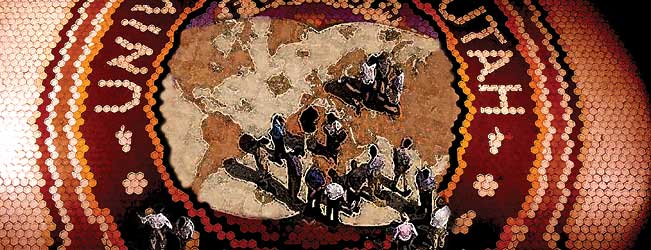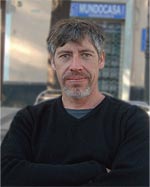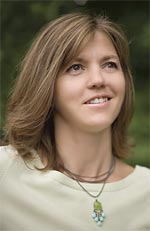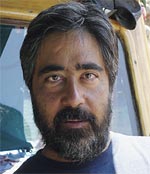

The Human Connection
Foreign faculty bring international experience to the classroom.
by Ann Jardine Bardsley
Perhaps the most tangible international connection on the University
campus is the human one—
the one that takes place between and among students, faculty, and staff.
The interaction might occur between domestic faculty who have international
ties, or between campus colleagues and students from foreign countries.
This intermingling of cultures has the same effect campus wide: Students
are transported from the classroom to other “global” environments,
broadening the scope of ideas and disciplines.
Some 15 to 20 percent of the U’s faculty hails from other countries.
In a typical year, the International Center processes and issues about
350 visas to both visiting scholars and tenure-track faculty. About
half that number ends up staying at the U; the others are on temporary
status and eventually return home.
Their stories, like the three presented here, illustrate how the U
brings the world to our doorstep, one professor at a time.
 Wild
Notion Wild
Notion
Julio Bermudez, Argentina
“Maybe this is cultural,” Bermudez says.
“Latins work in groups. My work is not bad alone, but I’ve
noticed that all of my best work has been done in collaboration.”
Some ideas need time to gestate, or must wait for the world to catch
up with them. Others need coaxing along through collaboration, and maybe
a “nice piano party” to facilitate them.
That’s what happened with Julio Bermudez, a native of Santa Fe,
Argentina, and an associate professor in the U’s College of Architecture
+ Planning (CA+P).
“Way” back in 1995, Bermudez had what he calls a “wild
idea.” “Traditional architecture is about bricks and mortar,
static and inert,” he says. “What if you could have architecture
that transforms with the life of a human being, in real time? So you
breathe, and the architecture does something. Your heart feels emotion,
and the architecture responds. What if I could create an environment
in which I could hook someone up, measure heart rate, brain waves, physical
and muscular activities, and take that data to build form and space?”
In other words, what if a body’s rhythms were integrated with
its environment? In 1995, those kind of ideas were considered fodder
for a science fiction film.
Enter the piano party. At just such a gathering some years later, Bermudez
struck up a conversation with Stefano Foresti, information visualization
specialist at the U’s Center for High Performance Computing. Together,
they developed the analog-digital design method and theory for which
Bermudez has received national and international recognition, a pioneering
work bringing architectural insight to the field of information visualization.
Jim Agutter joined the project while a graduate student in the CA+P;
since then, he has become the leader of information visualization work
at CA+P.
Bermudez’s work has lent itself to many multifaceted cooperative
projects, often with educators and researchers in different fields.
“Maybe this is cultural,” Bermudez says. “Latins work
in groups. My work is not bad alone, but I’ve noticed that all
of my best work has been done in collaboration.”
One such combined venture was cyberPRINT, a real-time, 3-D, dynamic
human architectural model, which also became a performance and computing
event. Another project involved a team of anesthesiologists, bioengineers,
cognitive psychologists, computer scientists, and musicians, who developed
a highly intuitive replacement for traditional medical displays. This
project and a variety of others utilizing similar technologies have
attracted more than $6 million in combined funding and include patent-pending
products now being commercialized. Bermudez’s collaborative work
also extends into finance, defense, and network monitoring.
Bermudez credits part of the relationship between his ideas and research
to his coming from a different culture. “I go home and I’m
not Argentine anymore. But I’m not American, either,” says
Bermudez. “But what this gives me is multi-perspective. I never
see concepts in just one way. Also, being from another culture, it’s
very uncomfortable to be unfamiliar, not to know. But obtaining creativity,
invention, and newness in research requires not knowing—or being
a fool at some point.”
Currently, Bermudez, who practices Zen and prefers renting a South
Temple apartment to purchasing real estate, is now focused on developing
a philosophy and practice of Voluntary Architectural Simplicity (VAS),
a move to pursue “essentialism.” VAS is one possible design
response to social and global challenges, explains Bermudez, a way to
be environmentally responsible, reduce complexity, and stop living life
in the fast lane—in short, to do more with less, and do it in
something other than a six-bedroom McMansion on a one-third-acre lot
scraped clean of vegetation.
“I profess the preservation of space. I am a minimalist at heart,”
he says. “I am exploring the process of remaining free by giving
up, letting go, and by voluntarily choosing to be innocent.”
 Taking
Stock Taking
Stock
Elena Asparouhova, Bulgaria
“Now I say to my students, ‘I’m
from Bulgaria, and I have a heavy accent. So the only way you get used
to it is to come to class.’ ”
As a fresh faculty member at the U, David Eccles School of Business
Assistant Professor of Finance Elena Asparouhova was frustrated with
students who complained to the department chair about her accent, her
phrasing, and the way she spoke to them. “Then I learned it was
partly my fault,” she says. “So now I say to my students,
‘I’m from Bulgaria, and I have a heavy accent. So the only
way you get used to it is to come to class.’ I’ve also learned
to speak louder and slower. I’m not a slow person; I just speak
English slowly,” she says.
That’s about all she does slowly. To use an American colloquialism,
she’s a real go-getter.
In 2003, the same year she came to the U, Asparouhova founded the University
of Utah Laboratory for Experimental Economics and Finance (UULEEF).
The project, patterned after a similar program at Caltech and recently
awarded a $120,000 grant from the National Science Foundation, uses
programs, computers, and statistical data to simulate financial markets.
UULEEF also involves University students who learn the system, trade
real securities, and earn money within a two- to three-hour time period.
The experiments are conducted bi-weekly, usually with 20 to 25 participants.
Earnings vary—averaging from $20 to $30 an hour, depending on
students’ performance. “We study the system in a controlled
environment with the goal of figuring out whether the theories we have
really work in real markets. The only difference between the lab and
the real world is we know so much more—because in the real world
they don’t know what the final payoff is going to be for IBM stock;
but in the lab we know the final distribution—and we come up with
much more precise results than advisors evaluating real-world data.”
In some ways, these sessions in experimental finance are much like
a game in which the participants win money by playing well. “Experimental
finance is lots of fun,” she says. “Students love it because
it is fun trading and they get paid.” Yet these simulations expose
students to the intricate workings of markets—both the highs and
the lows. Students register through the Web site (http://uuleef.business.utah.edu)
and are notified of upcoming sessions.
Asparouhova’s introduction to experimental research was through
her husband, who left Bulgaria in 1995 to accept a fellowship at Caltech.
“As Bulgarians, my husband and I were very poor,” she says.
“We collected $300 in six months, and this is all he had when
he came to the U.S. He called me from Caltech two weeks later, when
I was still in Bulgaria, and said, ‘You cannot imagine! At my
school there are people playing these games and giving you money for
playing them.’ He signed up for every experiment there—a
couple a day—and earned $400 or $500 in the first week. He said,
‘You should find out about what they are doing here, because it
is so cool and so much fun,’ ” she says.
Asparouhova immigrated a year later, studied English intensively, entered
Caltech, which already had well-established tracks in experimental research,
and earned a Ph.D. in economics.
And how does she play the market (the real one)? She invests only in
her pension, and her portfolio is “heavily biased toward real
estate.”
Asparouhova became a U.S. citizen last January. She says life in America
would be easier “in all other aspects” if she were not a
foreigner. “But having been in America and going back to Bulgaria
helps me more there. It gives me a lot,” she says, adding that
she incorporates her international experience into her teaching by saying
to her students, “Let me tell you what I’ve seen elsewhere….”
 Rich
Country, Poor Country Rich
Country, Poor Country
Korkut Erturk, Turkey
“It is interesting for [students] to be exposed
to people with very diverse experiences—especially graduate students,
where much of the interaction takes place outside of the classroom.”
Born in New York to Turkish parents, but schooled in Turkey, Professor
of Economics Korkut Erturk spent his politically turbulent high school
years (just prior to a military coup in 1980) pondering why some countries
are poor and some are rich. “I became interested in how economic
development relates to these situations,” says Erturk, chair of
the U’s Department of Economics since 2002.
A U.S. citizen by birth, Erturk returned to America at age 18. He received
his bachelor’s degree in economics at New York University, and
master’s and Ph.D. degrees from New School University.
Indeed, Erturk ended up specializing in macroeconomics or, in his words,
“why economies go through good and bad times.” He first
came to the U as a visiting professor and returned as a faculty member
in 1993.
“The University’s Department of Economics had a unique
focus—pluralistic, with an intellectually open-minded approach
to economics,” he says. “The department was willing to draw
from other disciplines or traditions in economics—as opposed to
other schools with a more narrow focus. That made the department very
interesting to me.”
He views economics as a social science, “as opposed to a technical
field like engineering, as many economists think in the profession.
The kind of economics we teach at the University has put us on the map
internationally. So that makes us attractive,” he says.
From 1997 to 2000, while on leave from the U, Erturk was the lead consultant
in drafting a document for the U.N. General Secretary on the economic
role of women in the global economy, a position that later helped him
place U of U graduates with the U.N. Development Program.
More recently, Erturk has been researching the role financial imbalances
play in business cycles and currency crises in developing countries.
He maintains that free flow of financial capital around the globe, if
not managed properly, can have adverse effects that can endanger globalization
as we know it.
Erturk’s cultural background, along with his extensive travel,
have given him a different regional and international perspective. “I
am capable of looking at the United States from outside. And having
an outside perspective is very valuable,” he says.
“I’m a believer in the importance of a liberal arts education.
Students are here to learn how to think critically and broaden their
horizons,” he continues. “It is interesting for them to
be exposed to people with very diverse experiences—especially
graduate students, where much of the interaction takes place outside
of the classroom. I guess I am one of the people of diverse experience
they can benefit from.”
—Ann Jardine Bardsley BA’84 is a writer in University
Marketing & Communications.
Return to fall 2006 table of contents
|



